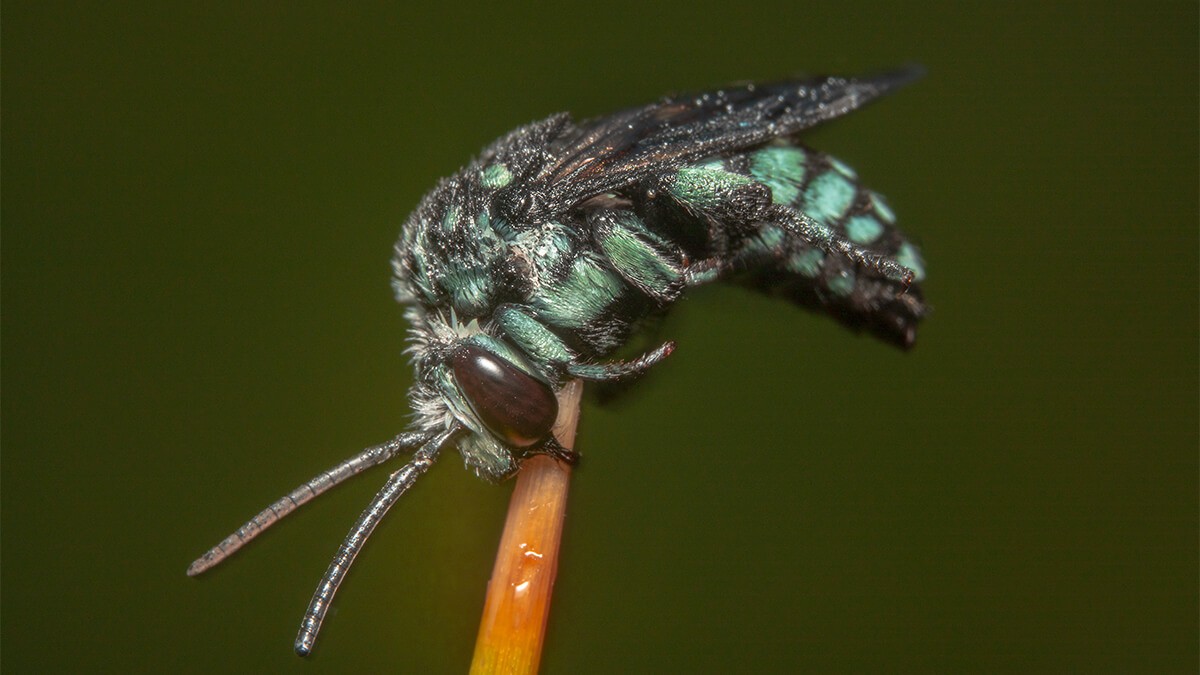Australian Cuckoo Bee

Cuckoo bees are some of the most interesting native Australian bee species. Instead of building and maintaining a nest, as normal bees do, they take note from their bird counterparts. Cuckoo bees use the nest of another, closely related species to lay their eggs in, often dooming the host's eggs in the process. This way they trick other bees to do their dirty work and raise their young, making them worthy of their name.
Cuckoo bees can be harmful to social bees if they remain undetected. Lucky for most potential victims, though, these brood parasites are few and far between. Even so, hosts get better at detecting them and cuckoo bees get better at tricking the hosts in a deadly game of cat and mouse.
Cuckoo bee identification
Cuckoo bees have the best cover, which sometimes makes them hard to identify. Their relation to the host, whose nest they intend to infiltrate, gives them the biggest advantage - a similar look.
The neon cuckoo bee (Thyreus nitidulus), for instance, can easily pass for a blue-banded bee, which is her main prey. Nevertheless, the best way to tell them apart is to look for pollen baskets, which the cuckoo bees are missing.
See also: Carpenter Bee - Indentification
Behaviour
Because of their inability to take care of their offspring, cuckoo bees have evolved to trick others into doing it for them. Since they are so dependent on their host, they have learned how to pick the proper one. Pollen-collecting species, as the blue-banded bee, make the perfect target. This way their offspring can use the gathered pollen as a food source.
Alternatively, cuckoo bee larvae can also snack on the host's eggs or larvae. Either way, if things get to that point, the host's young rarely (if ever) survives. This is why bee species that are frequently plagued by cuckoos develop the ability to better detect these parasites.
The female infiltrates the host's nest and makes her way to the brood chamber. She lays her eggs inside and ideally leaves undetected. The host then returns with the pollen and seals the cells. Little does she know there are intruders inside.
Cuckoo bee eggs then hatch before the host's eggs and start to grow fast. They eat the pollen and often the larvae of the host. Even if they don't kill them directly, the larvae starve to death. Either way, they die so that the cuckoo bees can live.
Even though cuckoo bees are solitary, they can also infiltrate hives. Their method is sneaky and involves lots of covert affairs that would make any spy proud. First, the female hangs around the nest without trying to get in. She's trying to cover herself in the hive's chemical markup, which is her ticket to getting in.
Once inside, she usually makes her way towards the brood cells and lays her eggs inside. She may or may not destroy the eggs of the queen. Either way, due to food shortages, her own brood will survive at the expense of the host.
After laying her eggs, she has two options, depending on the species:
- Run for the hills - attempt to escape the hive undetected or at least with her life;
- Kill the ruling queen - some species attempt to replace the queen by killing her and covering themselves in her pheromones. This way the cuckoo bee can trick the hive into taking care of several brood generations. However, because cuckoo bees cannot produce workers, the hive is destroyed not long after the death of the rightful ruler.
Check too: Bee Facts - What Makes Honeybees So Special
Distribution
Cuckoo bees are found throughout most parts of Australia, living in both the wooded and the city areas.
The neon cuckoo bee is probably the most attractive one, but there are two other popular kinds from the Thyreus genus, known as the domino cuckoo bee and the chequered cuckoo bee. They can be all found in the eastern and northern regions of the country.
Cuckoo bee & host - main differences
Biologically, cuckoo bees are a bit different from their host even though they are often (but not always) closely related. There are a few ways you can definitely tell them apart:
- Cuckoo bees are a bit bigger - size is definitely an advantage if it comes to a showdown between two bees. If the cuckoo bee tries to infiltrate a solitary bee nest and gets caught, she has to fight her way out.
- Stronger exoskeleton - for the same reason as above, cuckoo bees have a stronger external skeleton to protect them. It's useful when a cuckoo bee needs to get out through multiple stings if detected in a social host's nest.
- Bigger and stronger mandibles - some species of cuckoo bees kill and replace the acting queen of the hive. They need to be well-armed for that.
- Lack of pollen baskets - since they don't gather their own pollen, cuckoo bees have no pollen baskets.